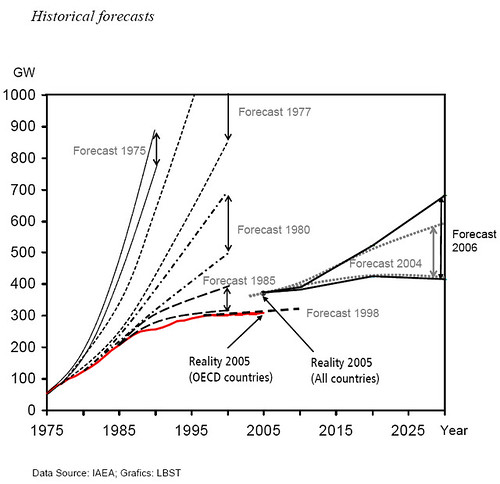As a percentage of global electricity, nuclear peaked at 16% around 2005 or 2006,
has declined to 14% now, and the IEA projects it will fall to 10% by 2035.
Even 10% may be high, scientists in China have been warning that government plans are over-optimistic.
For something which will only provide 10% of electricity while causing so many problems with accidents, disasters, waste, proliferation, security, etc, it's just not worth it. The money would be better spent on efficiency, renewables, etc.
http://www.neurope.eu/articles/International-Energy-Agency-chief-outlines-outlook-for-nuclear-power-/107672.phpInternational Energy Agency chief outlines outlook for nuclear power
Author: Lubomir Mitev
14 July 2011 - Issue : 944
<snip>
As such, Tanaka reported that the projections for increase of energy from nuclear power will be halved. Under the current scenarios, 360 gigawatt (GW) of new capacity would be built by 2035. In light of recent developments, a review of this situation shows that only 180GW will actually be realised, and most of this will happen outside the OECD. This implies that the share of atomic energy in the world will drop from 14% to 10%, leaving a gap between energy production and growing demand.
In new projections, named the New Policy Scenario, the IEA estimates that to replace nuclear power, roughly one-third of the gap will be filled by increasing production from coal, another third from gas, and the rest from renewable sources. In a startling comparison, Mr. Tanaka pointed out that this would require an increase of 130 million tons of coal (around the size of Australias current production), 80 billion cubic metres of natural gas (roughly Qatars production level), and 160 terrawatt-hours from renewables (five times Germanys current output). Taking into consideration the increasing prices of the first two sources, with renewable energy already being very expensive, electricity costs are set to rise. In essence, a complete phase-out of nuclear power would create enormous risks for Europes energy security.
<snip>
There's a logical error here - those new nuclear power plants won't be "replaced" by coal, those nuclear plants never would have been built anyway. Entergy, Exelon, Constellation all abandoned their plans for nuclear before Fukushima because "the numbers just don't work". France was already having major problems with it's new reactors. Etc etc. The old IEA projections were based on hype, bogus cost estimates, etc etc. That hype has caused a delay in build-out of renewables and is responsible for increased coal emissions.
The IEA and other agencies have historically overestimated nuclear growth.
Some historical data:
As a percentage of electicity, nuclear peaked at 16% around 2005 or 2006,
based on nuclear industry bogus cost estimates,
the 2007 IPCC report said it could increase to 18% by 2030:
http://en.wikipedia.org/wiki/Fourth_assessment_reportIn terms of electricity generation, the IPCC envisage that renewable energy can provide 30 to 35% of electricity by 2030 (up from 18% in 2005) at a carbon price of up to US$50/t, and that nuclear power can rise from 16% to 18%.
Renewables are currently 19% of electricity and growing:
http://en.wikipedia.org/wiki/Renewable_energyThe share of renewables in electricity generation is around 19%, with 16% of global electricity coming from hydroelectricity and 3% from new renewables.<2>
Wind power is growing at the rate of 30% annually, with a worldwide installed capacity of 198 gigawatts (GW) in 2010,<3><4> and is widely used in Europe, Asia, and the United States.<5> At the end of 2010, cumulative global photovoltaic (PV) installations surpassed 40 GW<6><7><8>
Here's an historical chart of IAEA forecasts for nuclear:
http://www.flickr.com/photos/16721844@N00/429450898/

Every two years the Nuclear Energy Agency (NEA) together with the International Atomic
Energy Agency (IAEA) publish detailed data about existing reactors, reactors under
construction, shut down reactors and also forecasts for the next 2030 years. An early
forecasts in 1975 predicted the nuclear capacity of OECD member countries to grow to
between 772890 GW by 1990. Based on such forecasts the uranium production capacities
were extended. But in reality, the installed capacity grew to 260 GW falling far below the
IAEA target range. The 1977 forecast was less ambitious, envisaging a range of between
860999 GW by 2000. As the year 2000 came closer, the more modest the forecasts became
eventually predicting a capacity ranging between 318395 GW by 2000. Actually, a total of
303 GW were installed in the year 2000. Every forecast by the IAEA in the past eventually
turned out as having been too optimistic.